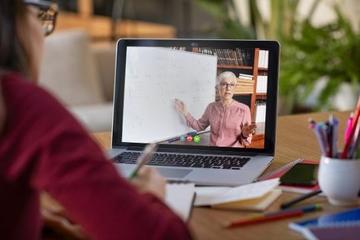March 11–14 and 18 & 19, 2024
Taller de lengua y lectoescritura en español | Spanish Language and Literacy Institute (¡en español!)
Cómo fomentar el desarrollo de la lectoescritura en español: Diferencias lingüísticas entre el español y el inglés y su impacto en la enseñanza del español | Fostering Spanish Language and Literacy Development
Aprenda estrategias efectivas basadas en investigaciones científicas para la enseñanza de la lengua y la lectoescritura en español en programas bilingües. | Learn research-based strategies to provide effective language and literacy instruction in K-8 classrooms where Spanish is the language of instruction.
This 15-hour institute provides research-based effective methodologies for teaching academic language and literacy in Spanish to students in K-8 in a wide variety of programs where Spanish is the language of instruction. An understanding of Spanish linguistic features frames classroom practices.
Questions? Email CAL with any questions you may have about our offerings.
Agenda
The institute will provide both synchronous and asynchronous online learning and will take place over five consecutive days. It will include:
1) Synchronous: Webinar meetings with CAL facilitators to discuss best practices in Spanish language and literacy instruction and network with other Spanish language educators from schools in the U.S. (12 hours); and
2) Asynchronous: A final project where participants apply their learning to create a lesson plan (3 hours).
Curriculum Overview
The following provides an overview of the topics covered over the five days. Practical classroom-based instructional strategies are embedded throughout the presentation, which will be delivered entirely in Spanish.
Introducción a la conciencia metalingüística
The Context for Metalinguistic Awareness Raising
- What does research say about effective biliteracy instruction?
- What is metalinguistic awareness, and why is it important?
- What are the fundamentals of language transfer?
Cómo desarrollar conciencia de las similitudes y diferencias entre el español y el inglés
Developing Awareness of Similarities and Differences between Spanish and English
- Fostering the development of academic language
- Building metalinguistic awareness to promote cross-linguistic transfer
- Examining similarities and differences between the languages related to:
- Phonology and orthography (sound-letter correspondences)
- Morphology (word formation)
- Semantics (with a focus on cognates and false cognates)
- Syntax (sentence structure)
- Pragmatics (language use)
La evaluación del desarrollo del lenguaje y la lectoescritura en dos idiomas
Assessing language and literacy development in two languages
- Assessment practices for language learners
- Assessing oral language
- Assessing side-by-side writing
Schedule (Eastern Time): March 11–14 and 18 & 19, 2024
| Monday, March 11, 3:00–5:00 p.m. | Webinar I: The Context for Spanish Language and Literacy Instruction in a Dual Language Program |
| Tuesday, March 12, 3:00–5:00 p.m. | Webinar II: Developing Awareness of Similarities and Differences between Spanish and English – Part I |
| Wednesday, March 13, 3:00–5:00 p.m. | Webinar III: Developing Awareness of Similarities and Differences between Spanish and English – Part II |
| Thursday, March 14, 3:00–5:00 p.m. | Webinar IV: Developing Awareness of Similarities and Differences between Spanish and English – Part III |
| Monday, March 18, 3:00–5:00 p.m. | Webinar V: Developing Awareness of Similarities and Differences between Spanish and English – Part IV |
| Tuesday, March 19, 3:00–5:00 p.m. | Webinar VI: Assessment Practices and Showcase of Lessons |
Venue
This institute will be held online using interactive webinars and a self-paced assignment.
Cost
Take advantage of the early bird pricing at $685 per person through February 12, 2024.
The price for an individual is $735 per person after February 12, 2024.
Send two people or more and pay $685 each.
Please register early, as there is limited space available.
Certificate of Completion
Participants who have attended all webinars and completed the project will receive a CAL Certificate of Completion for 15 hours, which may be used for continuing education credit, depending on the requirements of your state or district.
Cancellation Policy
Registrants: We encourage participants to let CAL know as soon as possible if they do not plan to attend the session. Participants may cancel their registration and receive a full refund up to three (3) weeks before the institute start date by sending an email to solutions@cal.org. After that date, no refunds will be available. However, registrants may choose to receive the institute materials by mail, postpone their attendance to a future CAL Institute, or transfer the registration to another individual up to three (3) days before the course start date. Contact us to discuss your options.
CAL: CAL reserves the right to cancel an event due to low enrollment or for reasons beyond our control. If we exercise this right, we will refund any registration fees paid in advance. In some instances, registrants may have the option to transfer their registration to another event. CAL is not responsible for transportation or hotel costs incurred by registrants.
Fair Use of Materials
Individuals who have completed CAL trainings and workshops have permission from CAL to use materials while providing professional development to educators in their school or school districts. These materials cannot be used to deliver fee-based services. Email CAL if you have questions about the use of CAL materials.
Questions?
If you have questions, please contact us via email at solutions@cal.org or call 202-362-0700, Monday–Friday, 9:00 a.m. – 5:00 p.m. Eastern Time.


